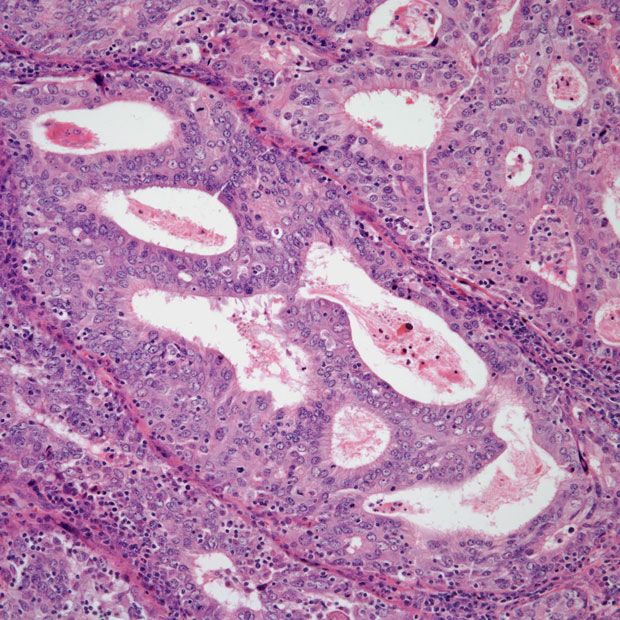Atezolizumab Combo Does Not Improve PFS in Recurrent Ovarian Cancer
Preliminary overall survival data with atezolizumab plus bevacizumab and chemotherapy in recurrent ovarian cancer in the phase 3 ATALANTE trial appear to warrant further analysis.
“Final OS results are anticipated in late 2024 and will provide important information on long-term effects in patients potentially deriving sustained benefit from [immune checkpoint inhibitors]," according to the authors of the phase 3 ATALANTE/ENGOT-ov29 trial (NCT02891824).

Adding atezolizumab (Tecentriq) to bevacizumab (Avastin) and chemotherapy did not produce meaningful differences in progression-free survival (PFS) compared with placebo plus bevacizumab and chemotherapy among patients with recurrent epithelial ovarian cancer, according to findings from the phase 3 ATALANTE/ENGOT-ov29 trial (NCT02891824).
Investigators reported a median PFS of 13.5 months in the atezolizumab arm vs 11.3 months in the placebo arm across the intent-to-treat (ITT) population, which did not fulfill the trial’s coprimary end point (HR, 0.83; 95% CI, 0.69-0.99; P = .041). Additionally, the median PFS in each respective arm was 15.2 months vs 13.1 months in those with PD-L1–positive disease, which did not reach statistical significance (HR, 0.86; 95% CI, 0.63-1.16; P = .30). There was no significant relationship between atezolizumab and PFS in any prespecified patient subgroups, including those with disease that was PD-L1 positive and CD8 positive.
In the atezolizumab and placebo arms, respectively, the objective response rate (ORR) was 62% vs 66% in the ITT population and 62% vs 61% in the PD-L1–positive population. Investigators reported a median time to first subsequent therapy (TFST) of 14.6 months vs 12.5 months in each arm across the ITT population (HR, 0.84; 95% CI, 0.70-1.01) and 17.5 months vs 15.2 months in PD-L1–positive patients (HR, 0.97; 95% CI, 0.71-1.32).
Although the data were immature at the time of the analysis, investigators highlighted a median overall survival (OS) of 35.5 months with the atezolizumab-based regimen vs 30.6 months in the placebo arm across the ITT population (HR, 0.81; 95% CI, 0.65-1.01). The OS rates in each respective treatment group were reported to be 89% vs 87% at 1 year, 67% vs 62% at 2 years, and 49% vs 38% at 3 years. Across the PD-L1–positive population, the median OS was 40.7 months (95% CI, 34.4-48.4) vs 33.6 months (95% CI, 29.6-52.1) in each respective arm (HR, 0.90; 95% CI, 0.61-1.32).
“Although PFS differences did not reach statistical significance, preliminary OS results showed an encouraging signal and warrant further analyses with longer follow-up,” the study authors wrote. “Final OS results are anticipated in late 2024 and will provide important information on long-term effects in patients potentially deriving sustained benefit from [immune checkpoint inhibitors].”
In the double-blinded ATALANTE trial, 614 patients were randomly assigned 2:1 to receive 1200 mg of atezolizumab once every 3 weeks (n = 410) or matched placebo (n = 204) for up to 24 months in combination with bevacizumab and chemotherapy. Chemotherapy options included platinum-based agents such as carboplatin, gemcitabine, and paclitaxel.
The trial’s secondary end points included OS, TFST, ORR, health-related quality of life (HRQOL), and safety.
Patients with histologically confirmed progressive nonmucinous epithelial ovarian cancer with first or second relapse following a platinum-free interval of more than 6 months were able to enroll on the trial. Additional eligibility criteria included an ECOG performance status of 0 or 1 and normal organ and bone marrow function.
Baseline characteristics were reported to be comparable across the study population. Most patients who received atezolizumab and placebo in the ITT population, respectively, had high-grade serous disease (84% vs 83%), an ECOG performance status of 0 (68% vs 64%), 1 prior line of chemotherapy (75% vs 72%), and no germline/somatic BRCA mutations (59% vs 58%).
There was no significant impact on HRQOL in either treatment arm with respect to difference in mean change in baseline QLQ-C30 global health scores (P = .074).
In the atezolizumab and placebo arms, respectively, grade 3 or higher adverse effects (AEs) affected 88% vs 87% of patients, grade 3 or higher treatment-related AEs (TRAEs) occurred in 33% vs 35%, and fatal AEs were reported in 3% vs 2%. Common any-grade autoimmune disorders in each respective arm included hypothyroidism (11% vs 5%), hyperthyroidism (2% vs 2%), and colitis or severe diarrhea (1% vs 2%).
Investigators highlighted that 25% and 18% of patients who received atezolizumab and placebo, respectively, discontinued their respective agents due to AEs. Additionally, 34% and 27% of patients in each arm discontinued bevacizumab due to AEs, and 15% and 15% of patients discontinued chemotherapy following AEs.
Reference
Kurtz JE, Pujade-Lauraine E, Oaknin A, et al. Atezolizumab combined with bevacizumab and platinum-based therapy for platinum-sensitive ovarian cancer: placebo-controlled randomized phase III ATALANTE/ENGOT-ov29 trial. J Clin Oncol. 2023;41(30):4768-4778. doi:10.1200/JCO.23.00529